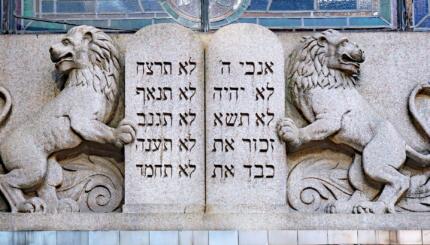The modern-day Arab-Israeli peace process began, in effect, with the Camp David talks between Israel and Egypt in 1978. During these talks Jerusalem emerged as a key issue.
Indeed, disagreement over Jerusalem, including Egyptian demands that Israel restore Arab sovereignty to all of East Jerusalem, almost destroyed the chances for Egyptian-Israeli peace. In the end the U.S. Secretary of State was able to keep the talks on track, however, by proposing that the official agreement make no mention of Jerusalem but be accompanied by three side letters–one from American President Carter, one from Egyptian President Sadat, and one from Israeli Prime Minister Begin–stating their countries respective positions. This compromise provided for an Egyptian-Israeli peace while offering the Egyptians an opportunity to save face in the Arab world and enabling the Israelis to keep Jerusalem off the bargaining table.
Jerusalem on the Table
In President Ronald Reagan’s 1982 peace initiative, the American president proposed that the status of Jerusalem should be determined through negotiations, a harbinger of the changing rules of engagement. Over the next several years, unrest grew in Gaza and the West Bank, and Intifada rioting would eventually spread to East Jerusalem, which was becoming increasingly important as a Palestinian cultural and political center.
With your help, My Jewish Learning can provide endless opportunities for learning, connection and discovery.
In 1988, King Hussein of Jordan declared his intention to disengage from the West Bank. In that same year, the Palestinian Liberation Organization announced the establishment of the State of Palestine, with Jerusalem as its capital, as well as a willingness to acknowledge the legitimacy of the state of Israel. As Mayor Teddy Kollek put it, “the situation in Jerusalem has changed in a fundamental way.” Jerusalem was on the table.
Madrid, Oslo, and Beyond
In October 1991, the United States and the U.S.S.R. convened the Madrid Conference for Peace in the Middle East. Palestinians attended the conference as part of a joint Jordanian-Palestinian delegation, which the Israelis were promised would not formally include representatives of the PLO. The bilateral meetings that took place between the Palestinians and the Israelis, however, developed into the secret Israeli-PLO negotiations in Oslo. These would lead to the historic signing of a Declaration of Principles in Washington, D.C. in September 1993 by PLO chairman Yasser Arafat and an unsmiling Israeli Prime Minister Yitzhak Rabin.
The Declaration of Principles contained concessions from both sides–while Jerusalem would not be included in interim Palestinian self-governing agreements, Jerusalem Palestinians would nonetheless be permitted to vote in the elections for the Palestinian Authority, and it was agreed that the Jerusalem question would be reintroduced during the permanent status negotiations, scheduled to begin in 1996.
During this period there were several other important diplomatic developments. In October 1993, Israeli Foreign Minister Shimon Peres sent a letter to the Foreign Minister of Norway confirming the importance of Palestinian institutions in East Jerusalem and promising that their activities would not be restricted. This letter, while not legally binding, was a diplomatic commitment to an ally, and demonstrated considerable evolution in the Israeli stance towards East Jerusalem.
The Beilin-Abu Mazen Agreement
The Oslo talks gave birth to perhaps the most viable proposal for peace written before or since. From 1993 to 1995, Yossi Beilin, Israel’s Deputy Foreign Minister and Mahmoud Abbas (also known as Abu Mazen), then a leading member of the Palestinian delegation, held secret talks, and in October of 1995 they presented a framework for a final status agreement. The Beilin-Abu Mazen agreement proposed the following:
1) Jerusalem would remain open and undivided, and people of all faiths and nationalities would continue to have unhindered access to the holy places; 2) the borders of Jerusalem would be expanded to include Abu Dis, al-Azariya, A-Ram, A-Zam, Maaleh Adumim, Givat Zev, Givon, and some additional areas adjacent to them; 3) neighborhoods inhabited by Palestinians would become Palestinian boroughs, and neighborhoods inhabited by Israelis would become Israeli boroughs, with the ratio of boroughs reflecting the Jewish-Arab demographic balance of 2:1; 4) the city would form a unified municipal government consisting of representatives of the boroughs; 5) in matters relating to the Palestinian areas of the city, the council would seek consent of the Palestinian government, and in matters relating to the Jewish areas the council would seek consent of the Israeli government; 6) there would be two sub-municipalities with considerable power on the local level, including control over taxation, local services, education, housing, and religious authorities; 7) the Western part of the city would be called Jerusalem, or Yerushalayim, while the Eastern part would be called Al-Quds, and each would recognize the other as a capital; and 8) open access to the holy places would be maintained.
General principles for talks on the status of the Old City, which they agreed would have a “special status,” were laid out, but not fully resolved. Discussion of the areas outside of the walls of the Old City of Jerusalem but inside the municipal borders (the new East Jerusalem) was put off until a later date as well.
The Beilin-Abu Mazen plan had substantial governmental support (at least within the dovish Labor government), but four days after it was finalized, Prime Minister Yitzhak Rabin was assassinated by a Jewish extremist. His successor, Shimon Peres, fearful that an unelected Prime Minister did not have the mandate to sign such a revolutionary document, chose to wait until the next election to push forward. The next year, however, would see an upsurge in Palestinian terrorism, and the Israeli electorate responded by ousting Labor from power. Under Likud’s Benyamin Netanyahu, discussions about the status of Jerusalem came to a standstill.
Barak and Arafat
Following the tenure of Netanyahu, the Labor party returned to power, determined to make up for the time and trust that had been lost. In July of 2000, Labor Prime Minister Ehud Barak met with Yasser Arafat and American President Bill Clinton to discuss final status issues. The future of Jerusalem figured prominently in their discussions, and, as the days wore on, became an impassable source of disagreement.
On day seven, the American delegation proposed a plan that ran along similar lines to the Beilin-Abu Mazen agreement but offered specific ideas regarding the Old City. According to this proposal, the Old City would be under Israeli sovereignty but administration of the Jewish and Armenian quarters would fall to Israel while administration of the Muslim and Christian quarters would fall to the Palestinians, and that the Haram al-Sharif would be under Israeli sovereignty but with Muslim (eventually Palestinian) control, with a Palestinian flag flying over it but equal prayer rights for Jews. Prime Minister Barak indicated that he would be ready to enter into such an agreement, but Yasser Arafat refused.
President Clinton, undeterred, came forth with an even more far-reaching proposal, offering functional Palestinian jurisdiction in some of Jerusalem’s internal neighborhoods and full sovereignty in neighborhoods on the periphery. Still Arafat was unsatisfied. “The Egyptians got back every last inch of Sinai,” he is said to have asked, “why should I give up Jerusalem?”
Of course, Jerusalem was not the only issue on the table. The division of the West Bank and the access to important water supplies contributed to Arafat’s decision. Arafat was often blamed for the failure of these negotiations–even by Clinton himself–but Beilin was among those who rejected this view. “The mistake was to put all the blame on Arafat, not only because he did not deserve it,” Beilin said. “Maybe he deserved part and maybe it is true that the Palestinians did not initiate ideas, but itwas a tactical mistake to put all the blame on one side.”
Trying Again
Six months later Clinton, weeks from the end of his term, the al-Aqsa Intifida already begun, brought together an Israeli delegation and a Palestinian delegation and tried once more for a peaceful resolution. According to this plan, Palestinians would be given sovereignty over Palestinian areas and Israelis would retain sovereignty over the Israeli areas. This would apply to the Old City as well, with the Palestinians controlling the Haram al-Sharif and the Israelis controlling the Western Wall and its associated sacred areas. Barak agreed to the proposal, with the exception of those parts of it pertaining to the Temple Mount. Arafat, however, once again said no. By this point it made no difference–both Israeli and Palestinian public support for the process had been lost.
The years of the Second Intifada conflict were bloody and disheartening. But the death of Yasser Arafat and the emergence of Kadima seemed to create new hopes for peace. Then, with Netanyahu’s appointment to Prime Minisiter in 2009, the status of Jerusalem again seemed to be off the bargaining table. Prime Minister Netanyahu has stated that Israeli sovereignty over an undivided Jerusalem is not up for debate. Still, should the negotiations about Jerusalem’s status resume, there are several possibilities for Jerusalem’s future: divided sovereignty over the entire city, favored by the Palestinians; Israeli sovereignty with concessions in the West Bank, proposed during Netanyahu’s first tenure; the Borough System, first proposed by former mayor of Jerusalem Teddy Kollek almost thirty years ago, which gives greater administrative powers to administrative councils, granting the Palestinians substantial autonomy while ensuring continued Israeli sovereignty and; limited Palestinian sovereignty, along the lines of the Beilin-Abu Mazen plan.
Yitzhak
Pronounced: eetz-KHAHK, Origin: Hebrew, Hebrew name for Isaac.



